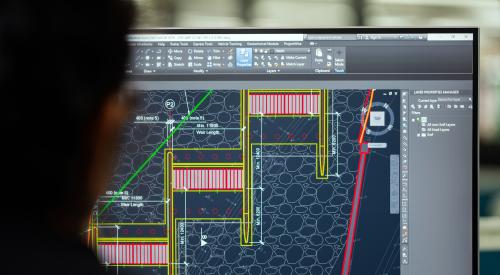Labor shortages have pulled the proverbial plug on production and efficiency for home builders. Sixteen different construction trades still face serious deficits of skilled workers, according to a summer 2019 report from the National Association of Home Builders. Fortunately, technological advances in the form of streamlined software solutions can counter those workforce woes with increased effectiveness and efficiency that help save both time and money.
Among the misperceptions about software platforms is that they are static solutions that can’t adapt to special business requirements or preferences, and that scheduling functions must fit into the larger accounting system, not the other way around. Companies have enough demands on their business, and they should be able to demand that construction management and scheduling software fits their approach and needs. For example, Homes by Taber, in Oklahoma City, Okla., uses a web-based software tool that handles scheduling, vendor and buyer portals, punch-item management, and safety assessments while offering a full reporting package.
Software platforms won’t do the framing, rough carpentry, or masonry for a home builder, but they can help a company be more organized and efficient. Builders will be able to do more with less and put personnel in the best position for success. Many builders manage construction scheduling in a disjointed way with emails, phone calls, and other antiquated, inefficient tactics. Before upgrading to a management and scheduling platform, Homes by Taber had superintendents “fighting” over the same trades because they didn’t know who was working on what.
How Tech Reduces Confusion
Construction management software reduces confusion, with advanced metrics and reporting, allowing a builder to drill down in detail by dates for a particular vendor, home, subdivision, etc. The checklists can eliminate a lot of phone calls and text messages, and frees up time that a builder can use to focus on moving houses.
The software also maximizes collaboration. In fact, the platform currently handles more than 450 Homes by Taber projects and is accommodating 85 employees, 135 vendors logging in four to five times a day, and 73 additional people who work with vendors. The “self-service,” easy-access portal makes vendors and contractors part of the team, which reduces follow-up.
Software can also increase collaboration. The “self-service,” easy-access portal in the software that Homes by Taber uses makes vendors and contractors part of the team, which reduces follow-up.
A construction management and scheduling system must be effective, but it also must fit the approach and setup of the builder, each one having a different mix of products and platforms to integrate. A huge priority for Homes by Taber was finding a system that is able to adapt to code modifications and changes with very quick turnaround. And for the most efficient data and workflow, it is absolutely essential that any builder software product provide the ability to exchange information with applications provided by other software vendors. An open, well-documented API, or computer interface, makes it easy and inexpensive to quickly develop integrated data-sharing solutions, often in less than a week’s time.
Tech Should Be Tailored to the Builder
The software should accommodate the builder and adjust to its requirements, not the other way around. After all, the priority is the business’ processes and objectives. Builders need to be able to continue working in a way that makes sense for them.
Homes by Taber’s software provider helped integrate its purchase order system so that all purchase orders are live in our construction management system. Now trades can not only see the project schedule but also how much they’ll get paid for a job.
The more knowledge one has, the more effectively one can act or react. Being able to plan out jobs far in advance allows builders and vendors to forecast material needs and allocate labor to various jobs in a more efficient way. For example, a door manufacturer can look in our portal to see how many doors are needed over the next three to five months. The purchasing team can then use that knowledge to negotiate bulk pricing with vendors because they are aware of the quantities needed.
Being able to plan out jobs well in advance allows home builders and vendors to forecast their material needs and allocate labor to various jobs more efficiently.
Responsiveness goes beyond the flexibility of the home building software architecture. Customers should be able to get technical issues resolved quickly and effectively. After all, when home building pros have to attend to a glitch or malfunction, it means they’re not focused on job No. 1.
Labor shortages can mean lost time, money, and opportunity, but technology is here to help. Before advances in construction management and scheduling, a personnel pinch would most certainly lead to project delays, cost overruns, and the inability to expand one’s business pipeline. Homes by Taber was mired in a disorganized system that even had personnel butting heads. By choosing an efficient, productive, and collaborative software, Homes by Taber was able to save time and money by maximizing data and streamlining its process. The results after three years of implementation are nothing short of impressive: Homes by Taber reduced cycle time by 28%, or approximately 45 days, which ultimately has a direct reflection to the bottom line.













